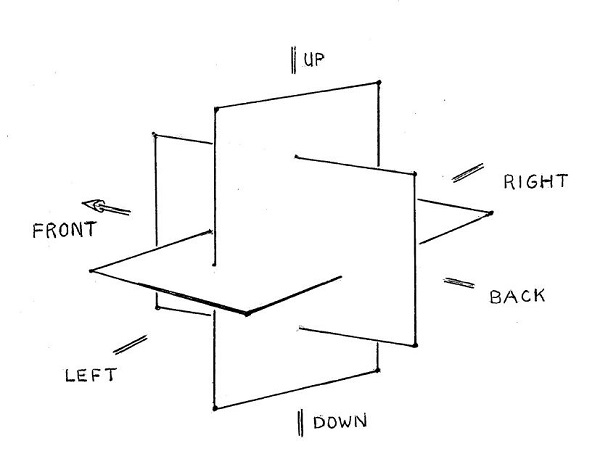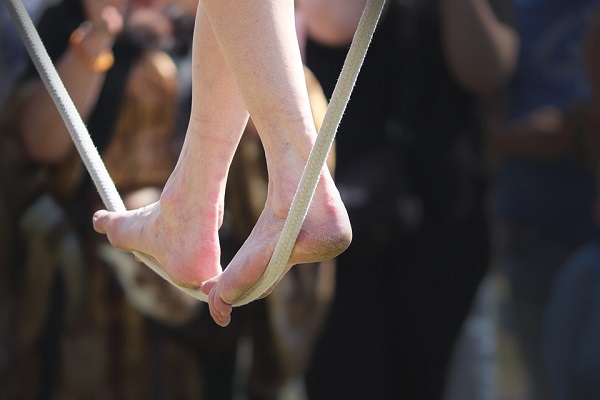Positive Health Online
Your Country

Posture And Balance
by Edwin Alan Salter(more info)
listed in movement, originally published in issue 289 - September 2023
Both of the terms posture and balance seem to speak of stillness, but it is rather that they are continually with us, most noticed when the flurry of activity ceases. And every movement begins from an initial state, and if that is uncertain or flawed the action itself is liable to go astray. As we grow older both essentials tend to deteriorate, and defects magnify so adding damage.
The words deportment, carriage and bearing are near banished, but their real importance endures. Deportment that lingered on in ‘finishing schools’ was central to the 1811 Mirror of Graces and encapsulated in the bemedalled Nelson on the quarterdeck at Trafalgar (not to forget the dancing Emma) with Philip’s smiling royal echo at the Diamond Jubilee Thames Pageant. Every military parade demonstrates soldierly bearing, an assertive display behaviour as common among animals.
It is important to appreciate that the body-mind link is two-way, both expressive and impressive. Everyday language commends “standing up for” and “holding your head high - chin up” to boost confidence when challenged. Similarly we feel better for smiling, but frowning inclines us to negative thoughts; laughing can be tried to lift mood. If we habitually droop and crumple we are likely to feel generally low, just as depression and inactivity are linked.
TightRope Walker
PhotoCredit: manfredrichter on Pixabay
Much of present life is sedentary, slumped, attentive to screens. But the ‘looking good’ pleasure of celebrities and models sets the target. The focus is image, and selfies record increasingly bizarre cosmetic surfaces and style fashions: some public figures and identity groups present their own specialness. Realities and future consequences for appearance and health are easily disregarded. Balance lacks the obviousness of posture, but its decline – perhaps indicated by clumsiness and stumbles - has implications for life span. Concern arising after a fall may be late for improvement. Balance emerges from a complex of varied mechanisms, and has to be deliberately measured.
The standing posture with bipedal walk was a great triumph of evolution (from primates to the hominid sequence including H. habilis & erectus) giving a distant view and freeing the forelimbs for multiple function and usefulness that aided the development of brain and thought. Our vertebral column still records its difficult evolution in multiple curves, convex and concave. Uprightness and the impacts of locomotion burden the spine with our weight, and lower vertebrae are correspondingly more substantial. Back troubles (especially lower) are frequent impediments to both health and employment (the largest single cause of time off, perhaps around 15M days annually in UK) but surgical treatment has a relatively poor record.
Important to both posture and balance is awareness of stability when our centre of weight is within the ground area of support. So a heavy load should be picked up not by bending far forwards but with body lowered by bending the knees. Movements such as freely flowing swings and twists (especially if there is a peripheral load) need particular care. Obesity carries the weight of two or three people on ordinary anatomy and base area (British 5 year olds now illustrate concerning changes - less height, more weight). Also relevant are lower limb oddities (different leg lengths and, in the curiosities of old language, pigeon toes, knock knees, club foot …) most obvious in gait.
Slow deterioration with age is often unnoticed and disorders such as osteoporosis and arthritis add vulnerability. From mid-life onward it is prudent to spend a little time every week to benefit both the musculoskeletal foundations of posture and the interacting sensory systems of balance. Physical activities described here are for monitoring and maintenance of wellbeing, not as defect remedies.

Planes and Axes
Posture
The spinal column of vertebrate animals is at the core of posture, from it extending limbs and the head with its frontal concentration of sense organs. The vertical of gravity, bilateral symmetry of morphology, and forward locomotion together define movement in space described by the three orthogonal axes (up-down, side-side, forward-back) and planes (coronal ‘door’, transverse ‘table’, sagittal ‘wheel’) and guide corrective exercise (and joining the 12 corner points of the planes as diagrammed creates a 20-sided icosahedron as the peripheral envelope of gesture).
Bends and rotations are essential to activity, individual vertebrae (with bony articulations and separated by intervertebral discs) contributing to an overall effect They are, top to bottom, 7 cervical (C1 & C2 specifically enable the tilting and turning of the head), 12 thoracic, 6 lumbar, 5 sacral fused with the pelvis, plus the coccyx. Most obvious damages with age are increases in spinal curves - lumbar lordosis, upper kyphosis (the frequent stoop), or an added sideways tilt scoliosis (idiopathic commonest in teen girls): small misalignments grow as weight leans beyond its support.
As a start to awareness, simply stand erect, weight equally distributed on feet slightly apart, and looking straight ahead. Improve the erectness – think perhaps of a pull up from the top of the head, or of military role, or of a graceful but confident presence. Check the frontal image in a mirror, perhaps have photos taken front, back and sides, and invite comment on your habitual posture.
Go outdoors and, having glanced to see that the ground ahead is level, walk straight forwards looking out and about attentively. Feel that the upper body is open, the breathing steady, the arms free, the legs confident in their rhythm (a mental tune can help). And be alert. Whenever you go out, at least begin with this self-awareness (shop window reflections may remind).
Interrupt long periods of unchanging posture with shorts intervals of contrasting activity that will also aid alertness. Avoid crumpled sitting, resting and sleeping postures. A simple reminder is lying straight on your back, arms out to the sides opening the chest, with a sense of lengthening head to heel: with arms beside the trunk, feel the effects of pulled up and straightened knees, and of rocking side to side as a whole then with slight twist emphases for upper and lower back (table). Standing, slowly alternate crouched ball roundedness (wheel) and widely extended flat openness (door).
A short period of lying on a slightly tilted surface (head lower) can feel beneficial. Or find a strong ledge that can be reached up to, then allow the fingers to take briefly just a little of the body weight from the feet, again easing the pressure on the vertebrae.
Balance
Diverse organs contribute to balance. Simplest to understand are the otoliths, basically balls within a sensitive capsule of fluid that record the vertical because held by gravity, and the semi-circular canals that measure directional components of acceleration as internal inertial movement is detected by sensors. The proprioceptor sensors and nerves of the musculoskeletal system report the changing relationship of body parts, our kinaesthetic sense. And vision identifies verticals and our proximity to objects. All this information is usually processed with no conscious attention.
Balance gradually deteriorates after youth. Poor balance is not easy to improve so it is well worth a small effort to sustain it by regular practice beginning early rather than when problems emerge. Because of the different sensory contributions, having a variety of physical activities in life is valuable. But it is also worth focal practice of balance itself. Obviously, danger of falling should be eliminated by having support immediately to hand and being away from hard or vulnerable objects.
A simple start is to stand with feet somewhat apart sideways and shift weight from one foot to another, building a slight rocking motion: then try (more difficult) with feet forwards-backwards. Facing a wall, fingers touching it, go up and down on toes calmly. Lightly holding a support, stand on one foot and move the free leg a little.
The balance time for standing on one leg (try each) is worth knowing. Stand in a safe place with support available and look forwards at a clear point. Then simply lift one foot off the floor and maintain balance until it becomes too wobbly and the foot goes down. We are primarily visual creatures and with eyes shut times are shorter and decline faster with age. (Rough guide times in seconds, eyes open/shut, are: age 30s 45/15; 50s 40/8; 70s 20/3).
Varied experience with the eyes shut can benefit. First stand, then add small safe movements of arms or head, then if confident simple to and fro side steps. While sitting or standing extend the arms directly in different directions, clap, bring distant fingertips together or trace patterns in space. The non-visual contributors to balance then play their part fully and the brain is differently active.
If feeling generally insecure or frail, a useful piece of advice is to think and check ahead before starting any movement: if then interrupted (a sudden thought or distraction) pause in the movement before reacting in any way. Do only one thing at a time. Choose secure footwear and at home declutter passageways, have good lighting, provide grips and eliminate slippery, mobile or irregular surfaces.
Falls lead to anxiety and withdrawal, impoverishing life. About 1 in 3 at 65+ and 1 in 2 at 80+ are likely to have a least one fall a year and (UK) the 65+ suffer about 100,000 hip fracture per annum with falls the commonest fatal injury for the 75+. If falls do develop, it may be worth having some training in how to fall so as to reduce damage (think of stage falls – even consider hip pads).
Concluding
The preceding has focussed on awareness and everyday concerns. Prevention of damage is best for ourselves and others. As to more specific exercises, the aim would be to find what suits your body, aspirations and lifestyle (my personal and teaching routines have developed over many years), and trial should be cautious. Suitable exercises to be a regular part of life are best learned when safely tailored by the teacher to quirks (inherent, due to habits or injuries …) and needs.
It can be very helpful to keep a record of health through life. Just a few notes annually can remind of lifestyle, diet and activity changes, health issues and treatments: include basic data such as walking speed and one leg balance time along with weight and height, blood pressure and pulse, toilet patterns and sleep duration. Another basic functional concern formerly more prominent is breathing, and it too connects with movement, state of mind and expression (Breath, Voice, Speech - PH 135 2007). In decent air, try deep breathing (standing well, intake fully, expel fully, note with fingertips the horizontal movement of both ribs and abdomen) to maintain good function.
In the background to all the above is the aim of better movement (Moving Well - PH 107 2005) and the illuminating study initiated by Rudolf Laban. This influenced both theatre dance and keep fit, and inspired the creative dance widely taught in schools and valuable to personal development (banished politically as too child-centred, non-economic, less easily tested). Many areas of study (dance styles, sport, yoga, osteopathy, ergonomics, gesture …) contribute understanding. Good posture and balance are starting points for a healthy variety and quality of physical activity to enhance self-expression and enable the tasks and pleasures of life.
Comments:
-
No Article Comments available
